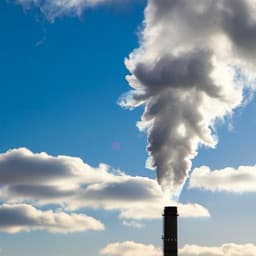
Environmental Studies and Forestry
Co-benefits of reducing PM<sub>2.5</sub> and improving visibility by COVID-19 lockdown in Wuhan
L. Yao, S. Kong, et al.
Atmospheric visibility provides intuitive grasp of air quality for public. China has suffered substantial visibility deterioration in the past years, which adversely impacts traffic and human happiness. Intensive occurrences of haze with low visibility have raised public awareness. Since the promulgation of Air Pollution Prevention Control and Action Plan in 2013, the national emissions of SO2, NOx, and primary fine particle (PM2.5) declined by 59, 21 and 33%, respectively. The PM2.5 mass concentrations in Beijing–Tianjin–Hebei, Yangtze River Delta, and Pearl River Delta reduced by 28–40% during 2013–2017. However, such great mitigations in air pollution are not directly visible to the general population because the ambient visibility seems less improved, especially in winter. For example, the frequency of low visibility events only decreased by 5% despite the reduction in PM2.5 > 30% in 2018 in Southern China when compared with 2013. This depressing visibility improvement is also found in Eastern China even though PM2.5 has lowered by 50.8 µg m−3 from 2013 to 2018. The annual average visibilities for Fenwei Plain and Central China are still < 10 km, and the haze days are still > 71 days. All these mask the intense and painstaking efforts that the government devoted for defending the blue sky. Aerosol light extinction (βext) including aerosol absorption (βap) and scattering (βsp) is the key deciding ambient visibility. The aerosol chemical compositions and hygroscopic properties impact βext substantially. Organic matter, (NH4)2SO4, and NH4NO3 are major contributors to βext in Chinese megacities, with SNA contributing up to ~80% under polluted conditions. Elevated relative humidity (RH) promotes SNA formation and enhances βsp via hygroscopic growth. For improving visibility, it is pivotal to identify key chemical components impacting βext and control their precursor gases. Temporary emission control measures during mega-events have reduced PM2.5 by 40–49% and sometimes improved visibility, but in some cases haze frequency did not decrease, implying that short-term regional controls may not always improve visibility. COVID-19 lockdowns provide a wide, long, and thorough natural experiment to assess impacts of stringent measures on aerosol optical properties. While large decreases in various pollutants were observed, severe haze still occurred due to unfavorable meteorology, enhanced secondary formation, and regional transport, and AOD was less affected. The impacts on aerosol optical properties remain unclear. Wuhan, the first and most strictly locked city, offers a case to analyze online datasets of bsp, bap, and PM2.5 composition for a pre-lockdown period (PLP) and lockdown period (LP). This study investigates how chemical compositions and hygroscopic growth affected βext, identifies the key component controlling βext, and proposes priority policies to effectively reduce PM2.5 and improve visibility.
Observation: Monitoring was conducted at a mixed residential/commercial site in Wuhan (114.28°E, 30.6°N) with no obvious industrial emissions. Periods: pre-lockdown (PLP: 2019/12/23–2020/01/22) and lockdown (LP: 2020/01/23–2020/02/22).
- PM10 and PM2.5 dry mass: oscillating balance method (TH 2000Z, China), hourly.
- Gases: CO (TAPI 300E), NOx (Casella ML9841B), O3 (TEI 49i), SO2 (Casella ML9850B), hourly.
- Water-soluble ions (NH4+, Na+, Mg2+, K+, Ca2+, Cl−, NO3−, SO42−) and gases HNO3, HCl, NH3: online ion chromatograph (MARGA-15), hourly.
- Organic carbon (OC) and elemental carbon (EC): Sunset OC/EC online analyzer (RT-4), hourly.
- Trace elements: Xact multi-metal monitor (Xact 625), hourly.
- Meteorology: pressure, temperature, RH, wind speed/direction (WS6000-UMB), hourly; precipitation from local met service; visibility by Belfort Model 6000 (±10% uncertainty); mixing layer height from HYSPLIT.
- Aerosol optics: Dry bsp at 525 nm by integrating nephelometer (Aurora-1000; RH of inflow air heated <40%); bap at 532 nm inferred from black carbon at 880 nm (Aethalometer AE-31) using a conversion coefficient 8.28 m2 g−1 and wavelength adjustment to 525 nm per Nessler et al. Single scattering albedo (SSA) = bsp/βext. Instrument verification/calibration per cited protocols.
Data screening: To avoid fog/rain/dust impacts, excluded hours with RH > 97%, precipitation, PM2.5/PM10 < 30% (potential dust), and PM2.5 > PM10. Eliminated data ~20% of total.
Reconstruction and apportionment:
- PM2.5 reconstructed as sum of (NH4)2SO4, NH4NO3, organic matter (OM), EC, and fine soil.
- OM split into primary (POA) and secondary (SOA) via minimum R-squared method with a constant conversion factor.
- Mass scattering efficiencies (MSEs) of (NH4)2SO4, NH4NO3, POA, SOA, and fine soil estimated by multiple linear regression (MLR); mass absorption efficiency (MAE) for EC from EC vs bap relationships. Statistics in Supplementary Table 1.
- Optical hygroscopicity factor f(RH) computed as ratio of estimated ambient bsp to measured dry bsp.
Thermodynamic and sensitivity modeling: ISORROPIA-II (forward mode) used to calculate aerosol water content (AWC), aerosol pH, and conduct sensitivity tests to NH3 (NHx) and total nitrate (TNO3 = HNO3 + NO3−) changes, based on average observed compositions for PLP and LP. Positive matrix factorization (PMF 5.0) applied to identify PM2.5 sources. Additional processing and abbreviations in Supplementary Methods/Tables.
- PM2.5 reduction and visibility improvement: Average PM2.5 decreased by 37.8% from 76.8 ± 34.0 to 47.8 ± 25.5 µg m−3 during LP; bsp and bap decreased by 39.0% (−151.2 Mm−1) and 31.4% (−8.9 Mm−1), respectively; visibility increased by 106.7% (+14.4 km). RH decreased slightly (−8.8%).
- Composition changes: NH4NO3 mass decreased by 24.8 µg m−3 and accounted for 63.6% of the PM2.5 mass reduction; SOA increased by 1.6 µg m−3 and its PM2.5 fraction rose by 6.9%.
- PTV10 thresholds and standards: PM2.5 thresholds for 10 km visibility (PTV10) ranged 54–175 µg m−3, decreasing with RH. An hourly PM2.5 standard of 54 µg m−3 is recommended to prevent haze. Lockdown elevated PTV10 by 9–58 µg m−3 across RH bins, indicating improved visibility at the same PM2.5 and RH.
- Optical efficiencies and hygroscopicity: Bulk MSE decreased by ~5% (−0.26 m2 g−1) while MAE increased by 24% (+0.06 m2 g−1) in LP. Optical hygroscopicity f(RH) decreased by 6–14% across RH ranges (from 1.57–3.46 in PLP to 1.48–3.12 in LP), a key driver of higher PTV10.
- Component-specific extinction: NH4NO3 contributed 61.8% (PLP) and 31.8% (LP) to βext; POA 22.1% and 28.1%; (NH4)2SO4 6.0% and 25.6%. Estimated βext from NH4NO3 declined the most (due to 56.1% mass and 28.8% MSE reductions), decreasing its βext contribution by ~30%. βext from SOA and (NH4)2SO4 increased (+15.0 and +40.3 Mm−1), despite a 29.4% sulfate mass decrease, reflecting size/aging effects.
- Hygroscopic enhancement and water: Differences between ambient and measured βext (Δβext) and AWC both decreased by ~60% from PLP to LP, tightly correlated (R2 = 0.86 for AWC–Δβext; R2 = 0.72 for AWC–visibility). Composition shifts explained 5.0–22.4% (Δβext) and 4.1–37.1% (AWC) of the reductions depending on RH.
- Deliquescence humidity and mutual promotion: Average PM2.5 deliquescence RH increased from 70.0% (PLP) to 71.3% (LP) (p < 0.01) due to reduced NH4NO3 fraction. Lower NH4NO3 weakened mutual promotion between aerosol water and nitrate, reducing AWC and Δβext and improving visibility.
- Control strategy efficacy (ISORROPIA-II): Variables responded nonlinearly to NHx reductions, with “sweet spots” at ~36% (9.2 µg m−3) for PLP and 43% (6.9 µg m−3) for LP near critical pH ~3. TNO3 reductions linearly decreased [NH4+ + NO3−] and PM2.5 and were more effective for visibility improvement than NHx reductions unless NH3 reductions exceeded ~69–73% (17.5 µg m−3 in PLP; 11.7 µg m−3 in LP). To achieve PM2.5 < 54 µg m−3 (visibility > 10 km) under PLP conditions: reduce TNO3 by 51% (17.9 µg m−3) or NH3 by 59% (15.0 µg m−3). Joint NH3–TNO3 reductions with various ratios did not lower these threshold percentages.
- Broader trends: Despite PM2.5 halving during 2014–2019 winters in Wuhan, visibility remained < 10 km; increasing nitrate fractions and aerosol optical hygroscopicity hindered visibility gains. Nonlinear visibility–PM2.5 relationships further explain limited improvements.
The study addresses why significant PM2.5 reductions in China have not proportionally improved ambient visibility, focusing on the roles of aerosol composition and hygroscopicity. During Wuhan’s COVID-19 lockdown, both PM2.5 mass and visibility improved markedly; analysis shows that reductions in NH4NO3 mass and its mass scattering efficiency, along with decreases in bulk hygroscopic growth (f(RH)) and AWC, drove visibility increases beyond what would be expected from PM2.5 and RH reductions alone. NH4NO3 dominated βext pre-lockdown and its strong hygroscopicity fosters a feedback with aerosol water that enhances light extinction. Lockdown weakened this mutual promotion, increased deliquescence RH, and thereby reduced hygroscopic enhancement of scattering, elevating PTV10 and improving visibility. Component-resolved optical efficiencies reveal that while sulfate mass decreased, aging and size distribution changes increased its MSE contribution to extinction, underscoring that composition and size effects can counteract mass reductions. Modeling indicates that controlling total nitrate (TNO3) more directly and effectively reduces [NH4+ + NO3−], PM2.5, and βext than equivalent NH3 reductions, except at very large NH3 cuts where aerosol pH and partitioning shift markedly. Thus, prioritizing TNO3 control (via NOx/HNO3 pathways) yields co-benefits for PM2.5 and visibility; however, in VOC-limited regimes, NOx reductions may raise oxidants, enhancing HNO3 formation, tempering TNO3 responses. The findings elucidate the nonlinear and composition-dependent mechanisms connecting PM2.5 to visibility, explain historically muted visibility gains despite PM2.5 declines, and support adopting stricter short-term PM2.5 standards (e.g., 54 µg m−3 hourly) to prevent haze.
This work demonstrates clear co-benefits of PM2.5 reduction and visibility improvement during Wuhan’s COVID-19 lockdown, primarily via substantial decreases in NH4NO3 mass and optical hygroscopicity that weakened the AWC–nitrate feedback, increased deliquescence RH, and elevated the PM2.5 threshold for 10 km visibility. Component-resolved optical analysis highlights nitrate’s outsized role in extinction under winter conditions. Modeling shows that controlling TNO3 is generally more effective than NH3 for improving visibility and reducing PM2.5, with NH3 control surpassing TNO3 only at very high NH3 reductions. Policy recommendations include: prioritize TNO3 reductions (while considering oxidant chemistry in VOC-limited regimes), adopt a strict hourly PM2.5 threshold of 54 µg m−3 to prevent haze, and implement regional joint controls because of transport influences. Future research should quantify secondary transformation responses of TNO3 and NHx to precursor controls, assess size distribution and aging impacts on component-specific MSE/MAE, and evaluate multi-pollutant strategies that also address nitrogen deposition and eutrophication. Even with improvements, LP PM2.5 remained far above WHO guidelines, indicating substantial further emission reductions are required.
- The thermodynamic modeling (ISORROPIA-II) did not explicitly include secondary transformation and oxidant chemistry; thus, responses of TNO3 and NHx to precursor (NOx, NH3) controls may differ under varying photochemical regimes (e.g., VOC-limited conditions can increase oxidants and HNO3 formation).
- Findings are based on one urban site in Wuhan and winter conditions; generalizability to other seasons/regions requires caution due to different meteorology, sources, and hygroscopic behavior.
- Instrumental and reconstruction uncertainties exist (e.g., conversions for bap, OM-to-POA/SOA split, MLR-derived MSE/MAE), and ~20% of data were excluded to screen fog/rain/dust, which may introduce selection bias.
- SOA hygroscopicity was not included in f(RH) estimation due to assumed minor contribution to bsp, potentially underestimating hygroscopic effects under some conditions.
Related Publications
Explore these studies to deepen your understanding of the subject.







